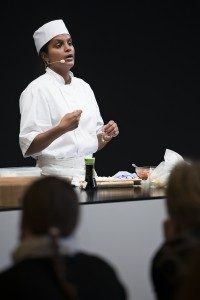
Sushi chefs in Japan have their very own definition of sushi. Sushi is vinegar-marinated rice with added local ingredients.
In Japan, you will often find Japanese sushi chefs that uses different types of fish and vegetables when they make sushi, and this applies to both nigiri and sushi rolls.
Japan is surrounded by the Pacific Ocean and you find many tropical fish in the area. Tropical fish that never reach European latitudes. Some of these fish are also used for sushi. There are types of fish that are best suited for nigiri, while others are used for both nigiri and sushi rolls.
In Japan, the selection of vegetables is large, there are many types of vegetables that cannot be found in Europe.
In Tokyo, Japanese sushi chefs make sushi rolls with either shiitake mushroom or pickled plum. These are not the only vegetables that sushi chefs use when they make sushi rolls.
If you travel to Japan, you should not be surprised if you are served a roll that contains raw materials that are not so common outside of Japan.
On the Sushi course for beginners, you learn step by step how to make tasty sushi from scratch with raw materials that are most in demand for sushi in Denmark.
Read more about Sushi course for beginners
_
Zoë has lectured and held sushi courses for A. P. Moller – Maersk, Hugo Boss Nordic, Novo Nordisk, Novartis, Velux, Gorrissen Federspiel, Beierholm revision, Elbek & Vejrup and many more.






